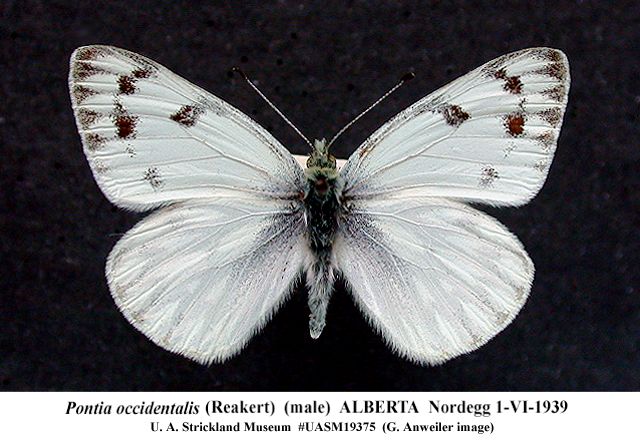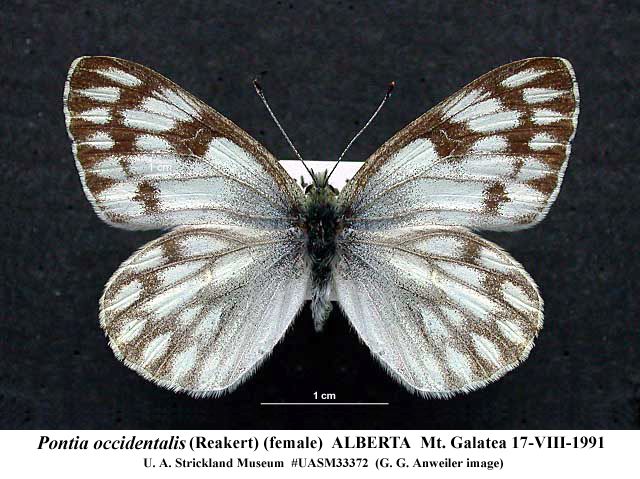« Back to BIRD37313
Species Details
Pontia occidentalis
University of Alberta E.H. Strickland Entomological Museum Read more about this collection »
Common NameWestern White
SeasonalitySingle- to multi-brooded, depending on the habitat, flying from April into September.
IdentificationThe Western White along with the other two Pontia whites, form a group of very similar species. The Spring White (Pontia sisymbrii) is easiest to distinguish; the dark vein markings on the hindwing underside are not connected laterally, and it occurs only in montane woodlands and extreme northern Alberta. The Western and Checkered White (P. protodice) are more difficult to separate. Males of the Western are more heavily marked than the Checkered, particularly on the underside. Females of both species have heavier markings than the males, but these markings are brown in P. protodice, not charcoal or black. Another characteristic is found on the underside of the forewing apex: P. occidentalis has the dark submarginal band connected with dark markings along the veins to the wing margin, P. protodice has only pale yellow scales here.
Individuals of the spring generation are smaller and have darker underside markings. Alberta populations are the nominate subspecies.
Scientific Name
Pontia occidentalis
Common Name
Western White
Habitat
Non-forested habitats throughout the province, particularly grasslands and alpine meadows.
Seasonality
Single- to multi-brooded, depending on the habitat, flying from April into September.
Identification
The Western White along with the other two Pontia whites, form a group of very similar species. The Spring White (Pontia sisymbrii) is easiest to distinguish; the dark vein markings on the hindwing underside are not…
The Western White along with the other two Pontia whites, form a group of very similar species. The Spring White (Pontia sisymbrii) is easiest to distinguish; the dark vein markings on the hindwing underside are not connected laterally, and it occurs only in montane woodlands and extreme northern Alberta. The Western and Checkered White (P. protodice) are more difficult to separate. Males of the Western are more heavily marked than the Checkered, particularly on the underside. Females of both species have heavier markings than the males, but these markings are brown in P. protodice, not charcoal or black. Another characteristic is found on the underside of the forewing apex: P. occidentalis has the dark submarginal band connected with dark markings along the veins to the wing margin, P. protodice has only pale yellow scales here.
Individuals of the spring generation are smaller and have darker underside markings. Alberta populations are the nominate subspecies.
Life History
The eggs are a dull orange colour. Mature larvae are blue-grey with a yellow dorsal and lateral stripe, and many black dots. Pupae are light grey with small black spots, and overwinter (Layberry et al. 1998, Guppy &…
The eggs are a dull orange colour. Mature larvae are blue-grey with a yellow dorsal and lateral stripe, and many black dots. Pupae are light grey with small black spots, and overwinter (Layberry et al. 1998, Guppy & Shepard 2001). Males display hilltopping behaviour, and can sometimes be found on mountain peaks over 3000m. In the mountains, there is only one brood that emerges in late spring, but there are two (sometimes a partial third) broods at lower elevations (Bird et al. 1995). This is our most common species of Pontia.
Conservation
Not of concern.
Diet Info
Although this is often a very common species, there are no larval foodplant records for Alberta. Wild mustards (Brassicaeae) are recorded elsewhere, including Lepidium, Cleome, Draba, Sisymbrium and Thlaspi (Layberry…
Although this is often a very common species, there are no larval foodplant records for Alberta. Wild mustards (Brassicaeae) are recorded elsewhere, including Lepidium, Cleome, Draba, Sisymbrium and Thlaspi (Layberry et al. 1998, Guppy & Shepard 2001).
Range
The Western White ranges from Alaska to western Ontario, south to California and New Mexico (Opler 1999).
References
Author
Opler, Paul A.
Title
A field guide to western butterflies.
Publication Date
1999
Pages
540
Author
Bird, C. D., G.J. Hilchie, N.G. Kondla, E.M. Pike and F. A. H. Sperling
Title
Alberta Butterflies
Publication Date
1995
Pages
349
Author
Guppy, Crispin S. and Jon H. Shepard
Title
Butterflies of British Columbia.
Publication Date
2001
Pages
414
Author
Layberry, Ross A.; Hall, Peter W. and J. Donald LaFontaine
Title
The Butterflies of Canada
Publication Date
1998
Pages
280
Specimen Information
There are 46 specimens of this Species.
BIRD35695 - Pontia occidentalis
University of Alberta E.H. Strickland Entomological Museum
Place CollectedCanada: Alberta, Kananaskis Country, Plateau Mountain
Collected ByBird, C. D.; Sawatzky, E. P.
Date Collected2012-07-30
BIRD37312 - Pontia occidentalis
University of Alberta E.H. Strickland Entomological Museum
Place CollectedCanada: Alberta, Kananaskis Country, Plateau Mountain
Collected ByBird, C. D.
Date Collected2014-08-01
BIRD37313 - Pontia occidentalis
University of Alberta E.H. Strickland Entomological Museum
Place CollectedCanada: Alberta, Kananaskis Country, Plateau Mountain
Collected ByBird, C. D.
Date Collected2014-08-01
BIRD38098 - Pontia occidentalis
University of Alberta E.H. Strickland Entomological Museum
Place CollectedCanada: Alberta, Kananaskis Country, Plateau Mountain
Collected ByBird, C. D.
Date Collected2016-07-24



